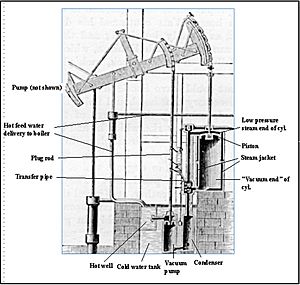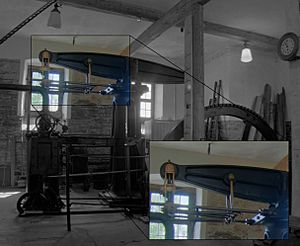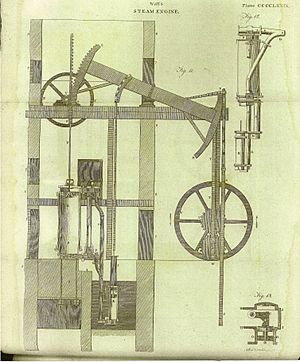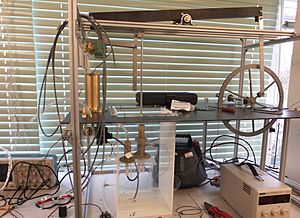Watt steam engine facts for kids
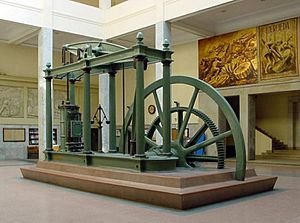
The Watt steam engine was a super important invention that changed the world. For many years, it was the main type of steam engine used everywhere. It was a big step up from earlier designs.
The very first steam engines were made by Thomas Newcomen in 1712. These were called "atmospheric" engines. Here's how they worked:
- Steam filled a cylinder.
- Cold water was sprayed in, making the steam turn into water (condense).
- This created a vacuum (empty space) inside the cylinder.
- Air pressure from outside pushed a piston down, doing work.
- But, the cylinder got cold each time, and then had to be heated up again for the next step. This wasted a lot of heat and fuel.
James Watt noticed this problem. He realized that a lot of heat was wasted by cooling and reheating the main cylinder.
Watt had a brilliant idea: what if the steam condensed in a *separate* chamber?
- Steam would go into the main cylinder, pushing the piston.
- Then, a valve would open, letting the steam rush into a *separate* cold chamber (the condenser).
- In this condenser, the steam would turn into water, creating the vacuum.
- The main cylinder stayed hot, ready for the next burst of steam!
This change made Watt's engine much more efficient. It used only half as much coal to do the same amount of work as Newcomen's engine. Watt also improved how the piston sealed, which stopped steam from leaking.
The new Watt engine started being sold in 1776. One of the first was for a company that made iron. Watt kept making his engine better. In 1781, he added a special "sun and planet gear" system. This turned the engine's up-and-down motion into a spinning (rotary) motion.
This was a huge deal! Before, steam engines mostly just pumped water. With rotary motion, they could power all sorts of machines. Factories could now be built anywhere, not just near rivers for water wheels. Watt's business partner, Matthew Boulton, helped make many new machines using this rotary power. They even built the first modern factory, the Soho Foundry.
Watt's early engines used low-pressure steam, like Newcomen's. Later, other companies made high-pressure engines. Watt was careful about high pressure because of safety. But he did make "double-acting" engines. This meant steam pushed the piston both up and down, making the engine more powerful and smoother. For these, he invented a clever "parallel motion" system to keep the piston moving straight.
Contents
Early Steam Engines
In 1698, an English inventor named Thomas Savery made a simple steam pump. It used steam to create a vacuum and suck water out of wells. But it could only lift water about 25 feet. This wasn't good enough for deep mines. It also used a lot of fuel.
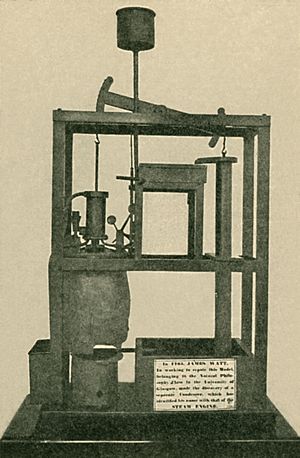
The problem of draining deep mines was solved by Thomas Newcomen. His "atmospheric" engine also used the vacuum idea.
- It had a cylinder with a piston connected by a chain to a big rocking beam.
- Steam entered the cylinder, and the piston rose.
- Then, cold water was sprayed into the cylinder. This made the steam condense and create a vacuum.
- The air pressure outside pushed the piston down.
- This pulled down one end of the rocking beam, lifting the other end.
- The pump, attached to the other end of the beam, pushed water up from the mine.
Newcomen's engine was much stronger than Savery's. It could lift water from over 100 yards deep! The first one, in 1712, replaced 500 horses used for pumping. Many Newcomen engines were installed across Europe. They were a big step forward.
However, Newcomen engines were not very efficient. The cylinder was heated by steam, then cooled by water, then heated again. This wasted a lot of energy with each stroke.
Watt's Big Idea: The Separate Condenser
In 1763, James Watt was fixing a model Newcomen engine at the University of Glasgow. He quickly saw how much energy it wasted.
In 1765, Watt had his breakthrough idea: a separate chamber for condensation, which he called a "condenser."
- The main cylinder stayed hot all the time.
- The condenser stayed cold and had low pressure.
- Steam went from the boiler to the hot cylinder, pushing the piston up.
- Then, a valve opened, and the steam rushed into the separate, cold condenser.
- In the condenser, the steam quickly turned into water, creating a vacuum.
- This vacuum pulled the piston down in the main cylinder.
By keeping the cylinder hot and the condenser cold, Watt's engine wasted much less heat. This made it far more efficient than Newcomen's engine. It used less coal to do the same amount of work.
Watt's condenser used a "jet condenser," where cold water was sprayed directly into the chamber. The warm water from the condenser was then pumped out and could even be reused in the boiler.
Watt also improved the engine by sealing the top of the cylinder. He even surrounded the cylinder with a "steam jacket" to keep it warm. He also found a way to use the steam's expansion to help push the piston. These improvements led to the successful engine design of 1776.
Working with Matthew Boulton
Watt's separate condenser idea was amazing, but he faced many challenges in building a working engine. It was only when he partnered with Matthew Boulton that his dream became real. Boulton was a keen businessman who agreed to fund the development. Watt finally had the tools and skilled workers he needed at Boulton's factory in Soho.
The fully developed Watt engine used about 75% less fuel than a similar Newcomen engine.
In 1775, Watt designed two big engines. One was for a coal mine, and another for an ironworks. They started working in 1776.
For years, Watt struggled to get perfectly round cylinders for his engines. This caused steam leaks. But in 1774, John Wilkinson invented a new boring machine that could make cylinders much more accurately. Boulton wrote that Wilkinson could bore cylinders "almost without error."
Boulton and Watt helped customers build engines and supplied special parts. Their main income came from charging a fee based on how much fuel their engines saved. This made their engines very popular in places where coal was expensive, like Cornwall.
Later Improvements
Early Watt engines were like Newcomen's, using atmospheric pressure. But Watt soon developed "double-acting" engines. This meant steam pushed the piston both up and down, making the engine more powerful and smoother.
Before, the piston was connected to the rocking beam by a chain, so it could only pull. But with double-acting pistons, the engine could push too. Watt needed a way for the piston rod to move straight up and down, while the rocking beam moved in an arc. He invented his famous parallel motion device to solve this. He was very proud of it!
With the double-acting engine, it was now possible to turn the beam's motion into a spinning motion for a wheel. Watt first used a "sun and planet gear" system. Later, he switched to the simpler crank system that most engines use today. A large, heavy wheel called a flywheel was added. This kept the engine's motion smooth and steady. Belts and gears could then be attached to this spinning shaft to power many different machines.
Factories needed machines to run at a constant speed. So, Watt connected a steam control valve to a centrifugal governor. This device, which he adapted from windmills, helped keep the engine's speed steady.
These improvements allowed the steam engine to replace water wheels and horses as the main power source for British industry. This freed factories from needing to be near rivers and was a key reason for the Industrial Revolution.
Watt also invented the "indicator diagram." This device measured the steam pressure inside the cylinder as the piston moved. It helped engineers understand and improve how the engine worked.
Preserved Watt Engines
- The oldest Watt engine still existing is Old Bess from 1777, now in the Science Museum, London.
- The oldest working engine in the world is the Smethwick Engine, from 1779, now at Thinktank in Birmingham.
- The 1812 Boulton and Watt engine at the Crofton Pumping Station in Wiltshire is the oldest still in its original building and still working! It pumps water for a canal.
- The oldest spinning steam engine, the Whitbread Engine (from 1785), is in the Powerhouse Museum in Sydney, Australia.
Many other Watt engines are preserved in museums around the world, showing their lasting impact.
-
The 1817 engine in Birmingham, England
-
Watt atmospheric pump engine (1796) at The Henry Ford Museum
Modern Ideas from Watt's Engine
Even though Watt's engine is old, some of its ideas are still useful today! There's a lot of wasted heat from factories and power plants, or from things like solar energy. This heat is often between 100 and 150 degrees Celsius.
Modern systems like the Organic Rankine Cycle can use this heat, but they are often complex. Watt's "Expansion Engine" idea might offer a simpler solution for smaller power needs (2 to 100 kilowatts).
- It uses water, which is cheap and safe.
- It works at low pressures, so sealing is not a big problem.
- It's a simpler machine, which means it could be cheaper to build.
Researchers at the University of Southampton in the UK are working on a modern version of Watt's engine. They are trying to use it to generate electricity from waste heat. They've even built a small 25-watt model to test their ideas.
See also
- Carnot cycle
- Corliss steam engine
- Heat engine
- Thermodynamics
- Preserved beam engines
- Ivan Polzunov


